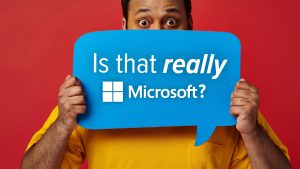 You get an email from Microsoft. It looks legit. Maybe it says your account’s at risk and urges you to act fast. But here’s the question: is it really Microsoft… or a phishing scam?
You get an email from Microsoft. It looks legit. Maybe it says your account’s at risk and urges you to act fast. But here’s the question: is it really Microsoft… or a phishing scam?
Cybercriminals love impersonating trusted brands—and Microsoft tops the list. In early 2025, 36% of brand-related phishing attacks were disguised as Microsoft. Google and Apple weren’t far behind.
These scams are slick. They use real logos, spoofed email addresses, and websites that look identical to the real thing. Their goal? Trick you into clicking a link, downloading malware, or handing over sensitive info.
So how do you stay safe?
- Slow down. Urgent language like “click now or lose access” is a red flag.
- Check the sender’s email address carefully—look for sneaky typos.
- Don’t click links from suspicious emails. Instead, type the official URL into your browser.
Phishing is getting smarter. But so can you. Train your team, use multi-factor authentication, and stay alert. Need help building a phishing-resistant culture? We’ve got you.







